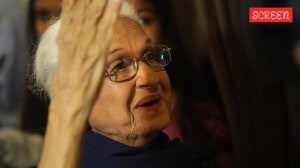Stay updated with the latest - Click here to follow us on Instagram
Classic goes digital
You can call this one a Bible for nature connoisseurs. BNHS,the 125 year-old conservation research NGO...
BNHS documents 100 years of its timeless Journal issues in a DVD
You can call this one a Bible for nature connoisseurs. BNHS,the 125 year-old conservation research NGO,has put out the first 100 volumes of its classic four-monthly Journal of the Bombay Natural History Society (JBNHS) in a DVD for a price of Rs 1,000.
The Journal was first published in 1886. Today it is recognised by experts worldwide as a premier scientific peer-reviewed periodical on natural history and a seminal database for information on the biodiversity of the Indian subcontinent. The DVD contains all the priceless articles and research papers published by naturalists and scientists like the bird man Dr Salim Ali,Humayun Abdulali and JC Daniel. It even documents the published works of the original greats who started BNHS,including E H Aitkens and Herbert Phipson. Interesting articles by nature lovers like Jim Corbett and George Schaller are also covered in the volumes.
Naturalist and photographer Issac Kihimkar,an old-timer at the BNHS,who recently released The Book of Indian Butterfly,said,When the Journal began,it was a compilation of writings by scientists as well as amateurs. Articles by many British experts of the era,Maharajas,hunters (known as sportsmen in those times) would be put together. Today it has evolved into a professional,scientific journal of international importance.
According to him,the Journal DVD is a one-of-its-kind collection,considering that the periodical is looked upon as a treasure-house,simply because of its unbroken record of Indias flora and fauna. This magazine survived two World Wars and a changing bio-diversity. It has relentlessly studied,compared,documented and researched the changing scenario of the countrys ecosystem and heralded several discoveries, he said. Among its innumerable firsts are the surveys on birds,mammals,bats etc,but what is most valuable are its studies on neighbouring countries.
Interestingly,the BNHS made a humble beginning on September 15,1883,when eight residents of Mumbai six Englishmen and two Indians,casually met in the Victoria and Albert Museum (now the Bhau Daji Laud museum in the Jijamata Udyan),and decided to form a society for the study of natural history. They met regularly,exchanged notes and discussed observations with each other for several months,till H Phipson,a nature enthusiast and a wine seller,offered the use of his shop at 18 Forbes Street,Fort,for meetings in January 1884.
The first volume of JBNHS which rolled out from this shop in 1886 didnt have its customary Hornbill logo but horns of three species of sheep drawn by artist R A Sterndale,members reminisce. The now-popular logo of the Great Hornbill,was inspired by a hornbill named William,which is said to have lived on the premises of the Society from 1894 to 1920.
JBNHS first photograph a black rock scorpion giving birth to twins parturition and first lithograph showing remains of a Nilgai ,partially eaten by a tiger is said to have appeared in its third volume in 1888.
Kihimkar said,JBNHS is probably the only non-stop documentation of the countrys natural history since the 1800s. Many scientists internationally consider these volumes a basis of their research and surveys. The DVD collection would clearly help them in their work.
The JBNHS DVD is available at the Hornbill House for Rs 1,000. You can also visit http://www.bnhs.org and order a copy.







